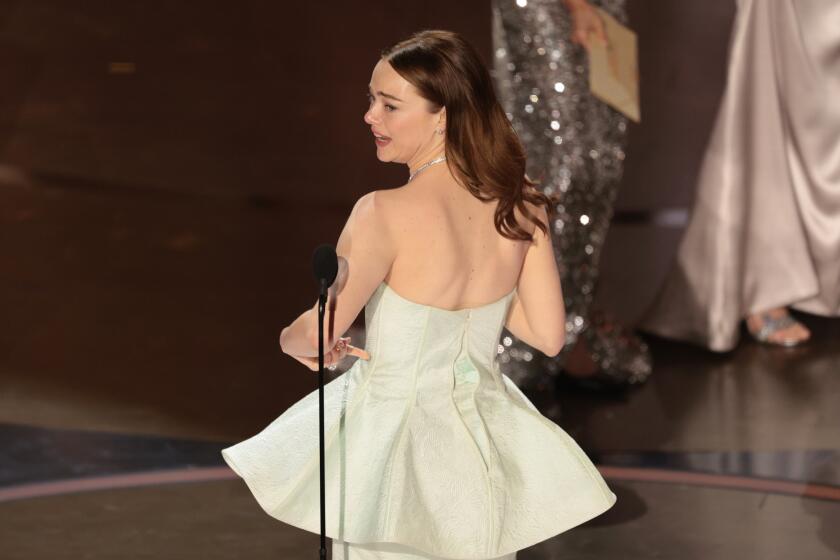Ailing, but Still Chasing Oscar Gold
“The Silence of the Lambs” will not be silent. “Thelma & Louise” will not be demure. And “Rambling Rose” will no longer be aimless.
The people behind those movies are going for Oscar gold--even if they don’t have the kind of money it usually takes to campaign for Hollywood’s top honors.
All three are in the ironic situation of having been recognized with a total of 15 Academy Award nominations, and yet the three film companies that distributed them have been in financial hot water.
The result has been a limited ability--if at all--to conduct the kind of high-profile publicity campaigns that are now popping up in Hollywood on behalf of other multi-Oscar-nominated films such as TriStar Pictures’ “Bugsy,” Walt Disney Pictures’ “Beauty and the Beast,” Columbia Pictures’ “The Prince of Tides” and Warner Bros.’ “JFK.”
“We’re putting together a guerrilla campaign, using our own money and time,” said Martha Coolidge, the director of the wistful, Southern-set drama “Rambling Rose.” The movie received nominations for Laura Dern as best actress and her mother, Diane Ladd, as best supporting actress, but it has been virtually “invisible” to academy voters because it has been out of theatrical release in New York and Los Angeles since December. Videocassettes of the film are not due in stores until just days before the March 30 Academy Awards ceremonies.
“Carolco Pictures doesn’t have a lot of money to support my movie,” Coolidge said, “so whatever work is done will be voluntary and donated.
“You see so much money and exposure being put into those other Oscar campaigns . . . all we can do is concentrate on just getting people to see our film.”
But, Coolidge added ruefully, “It just raises the real question: Is this about the money that’s spent, or is it about the quality of the work?”
Around this time of year in Hollywood, that question isn’t so far-fetched.
From last week, when Oscar nominations were announced, until March 24 when ballots are due, the nominees will be making the rounds at luncheons, receptions, awards programs and on such talk shows as Johnny Carson, Arsenio Hall and Larry King.
There will be special screenings of nominated movies for the members of the Academy of Motion Picture Arts and Sciences. And the two entertainment trade newspapers, the Hollywood Reporter and Daily Variety, are growing fatter by the day with splashy full-color ads reminding voters about the work of various nominees. Especially prolific to date have been ads on behalf of nominees distributed by Sony Pictures Entertainment’s two studios, Columbia and TriStar, as well as ads for Disney’s “Beauty and the Beast.”
Some see the campaigns as essential to remind the voters of a movie’s virtues--especially one like Orion Pictures’ “Silence of the Lambs,” which is ancient by Hollywood standards--having premiered more than a year ago. The suspense thriller received seven nominations, including best picture, Anthony Hopkins for best actor, Jodie Foster for best actress, Jonathan Demme for direction and Ted Tally for screenplay.
Despite Orion’s status in Chapter 11 reorganization, a spokesman said that the company is waging a campaign on behalf of the film to augment an extensive pre-nomination effort. That very visible effort included the mailing to each voter of a slick black box containing a soundtrack cassette and videotape of the movie.
“We are not spending a huge sum of money this time around, but we are purchasing ads . . . now that we have the nominations, there really isn’t all that much more that we can do,” the spokesman said. “Ads won’t really sway any votes.”
Few Oscar watchers can recall a year when so many categories have no favored winners. No one movie emerged by the Christmas season to dominate the annual critics’ awards or the often-prescient Golden Globe Awards that were announced in January. As of now, any clues to the way the Oscar winds are blowing will have to wait for two events--the Directors Guild awards on March 14 and the Writers Guild awards on March 23. Both guilds have strong track records for picking winners who go on to receive Academy Awards.
The lack of an apparent leader has made the pursuit of visibility even more important. Said one veteran of past Oscar campaigns: “When you have five strong nominees in so many categories, what else can you do but try to keep your title in front of voters?”
But even people who work on the campaigns often express reservations about the effectiveness of their efforts, which can cost anywhere from $300,000 to $3 million in the months between Thanksgiving and Oscar night. With the cost of full-color trade paper ads beginning at $4,000 per page and roughly $40,000 at a pop to mail nearly 5,000 videocassettes to all academy voters, plus gifts and color booklets, the costs can mount quickly.
“No one sets out to buy a vote,” said film publicist Dick Guttman, a partner in the firm of Guttman & Pam. “But there is a certain morality to wanting to get as many people as you can to see a film. Seeing the film is the key.”
He recalled telling his Oscar-nominated client Cicely Tyson in 1972 that even if 100% of the people who saw her performance in the little-seen “Sounder” voted for her, she would still lose. That’s because if only half of the people who saw the more widely viewed “Cabaret” voted for Liza Minnelli, Minnelli would win.
Minnelli won.
It’s exactly that kind of situation that prompted director Coolidge and many in the “Rambling Rose” company to work voluntarily on efforts to get their film seen by more voters--including a possible re-booking of the film in Los Angeles.
Coolidge said that she and producers Renny Harlin and Edgar Scherick, plus publicity firms representing the movie, stars and others connected with the film, will put together a grass-roots effort. They will send mailers to announce screenings and to inform voters that videocassettes can be requested.
“Many of us are donating our own money for making videocassettes,” Coolidge said. The cost of screenings will be borne by several Hollywood-based companies, the Women in Film organization will take out ads and the William Morris Agency will host a party for its client, Ladd.
Most of MGM/Pathe Communications Co.’s efforts to promote the female buddy movie that it released last spring, “Thelma & Louise,” took place before the nominations. The film ended up with five nominations, including two for best actress--Susan Sarandon and Geena Davis--plus director Ridley Scott and screenwriter Callie Khouri.
“We are simply doing a reminder program, primarily the trade newspaper ads and some dates in theaters so the film can be seen on the big screen,” said MGM President of Worldwide Marketing Greg Morrison. The company had recently been rescued from bankruptcy thanks to a cash infusion from the European lending giant Credit Lyonnais.
“Thelma & Louise” is currently on top of video rental charts. “If we get some Oscar winners, it could mean some difference in the home video and theatrical markets in the rest of the world,” Morrison said, citing the example of MGM’s 1987 “Moonstruck,” which, he said, generated $50 million in additional revenues after Cher won a best actress Oscar.
“The Oscar campaign is an important statement about trying to move the lion back into a front position,” Morrison said.
The company is buying equal numbers of full-color ads for both best actress nominees, he said. “Of course, it’s going to be a tie,” he joked about the outcome.
“It’s entirely possible that the two could cancel each other out. It’s not something we’re happy about. But fate has decreed that Thelma and Louise travel together.”
More to Read
Only good movies
Get the Indie Focus newsletter, Mark Olsen's weekly guide to the world of cinema.
You may occasionally receive promotional content from the Los Angeles Times.






